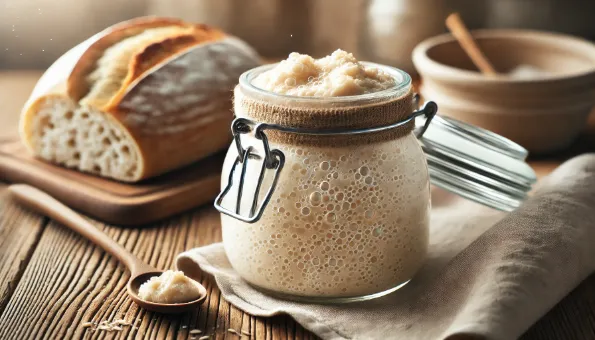Sourdough Starter: A Living Symphony of Wild Yeast & Lactic Bacteria
In just flour and water, wild microbes raise bread, add tang, lower FODMAPs and unlock minerals—if you keep them happy with regular feedings.

What Exactly Is a Starter?
A sourdough starter is a **50 : 50 slurry of flour and water** that becomes home to wild *Saccharomyces* yeasts and *Lactobacillus* bacteria. Yeast produce carbon-dioxide bubbles that lift dough, while the bacteria release lactic and acetic acids that give sourdough its gentle tang, extend shelf-life and slow staling. Unlike commercial baker’s yeast—which is a single strain—starters are miniature ecosystems that adapt to your kitchen’s temperature, flour choice and feeding rhythm.
Why Bake with It?
- **Flavour & Aroma :** organic acids, esters and alcohols create complex notes impossible to fake with straight yeast.
- **Nutrition :** acids lower pH, helping phytase unlock iron, zinc and magnesium bound in whole-grain bran. Long fermentation also **reduces FODMAPs and gluten peptides**, making bread gentler on sensitive guts.
- **Keeping Quality :** the acidic environment inhibits mould, so loaves stay soft and fresh up to a week without additives.
Average Composition (100 g fed starter, 100 % hydration)
|Calories|Protein|Fat|Carbs|Fiber|Sodium|
|---|---|---|---|---|---|
|≈ 98 kcal|3 g|0.5 g|19 g|2 g|<5 mg|
Drawbacks & Work-arounds
Maintaining a starter means daily (or at least weekly) flour “feedings”, which some bakers see as wasteful. To minimise discard, keep a **mini-starter (20 g total)** and scale up only the night before baking. Starters also dislike temperature swings below 5 °C or above 35 °C—if you travel, smear a thin layer on baking paper, dry overnight and store as flakes that re-hydrate in 24 h.
Feeding Schedule & Baker’s Math
Most recipes work with **15–25 % starter (baker’s percentage)**. A 1 : 1 : 1 feed (e.g. 20 g starter + 20 g water + 20 g flour) usually doubles in 4–6 h at 25 °C. For tangier bread, feed 1 : 2 : 2 and ferment longer; for milder flavour, refrigerate the fed starter and use it cold to slow acid build-up.
Long-Term Storage Options
- **Room Temp:** feed every 12 h.
- **Refrigerator (4 °C):** feed 1 : 2 : 2 once a week.
- **Freezer (–18 °C):** mix with equal flour until crumbly; keeps 6 months.
- **Dried Flakes:** air-dry thin sheet; shelf-stable 1 year in airtight jar.
- 1. Sourdough Starter

